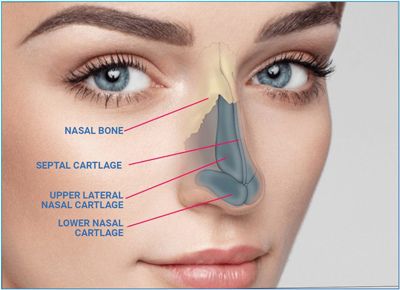What is Adult Rhinoplasty?
The nasal structure of the nose, being the most defining centralized feature of the face, has a very major impact on person’s overall appearance and confidence level. Even a slight alteration in adenoidal shape and structure can often than not significantly improve and transform an individual’s looks.
Best rated plastic surgeon Dr. Monica Tadros specializes in adult rhinoplasty for her patients in NYC & NJ and Bergen County.
“Rhino(nose)-plasty(shaping)”, also known as a “nose job,” is a surgical procedure which can rework the size and/or form of the nose, changing a person’s outline or profile, as well as relieve some breathing problems or other dysfunctional concerns.

There are many fluctuations to the nose that can be achieved through rhinoplasty, including a revision, a reduction or an increase in the size of nasal bridge or nasal tip, refinement of the nasal tip, a modification in shape, size or reduction of the nostrils, or even an adjustment in the angle between the nose and upper lip.
Request your no-obligation adult rhinoplasty consultation in NYC & NJ with Dr. Monica Tadros today.
You may also call our office to speak to one of our Patient Advisors at (201) 408-5430.
4 Distinct Types of Rhinoplasty:
- Cosmetic rhinoplasty improves the nasal shape and its proportion to the rest of the face.
- Functional rhinoplasty alleviates breathing difficulties.
- Reconstructive rhinoplasty rebuilds a severely damaged or congenitally malformed nose.
- Revision rhinoplasty, also known as secondary rhinoplasty, corrects a suboptimal result from earlier surgery.
A Good Candidate for Rhinoplasty
- Has maintained good overall physical health
- Perceives realistic expectations
- Is looking to recover or advance the aesthetic and/or functionality of the condition of their current nose
Adult Rhinoplasty
Rhinoplasty should not be performed on younger patients whose nose has not fully completed all of the developmental stages. The nose tends to be finished growing approximately around the age of 15 for girls and 16 for boys. There is no maximum age limit for rhinoplasty as long as the patient is reasonably healthy and has no medical contraindications to anesthesia.
Adult Rhinoplasty Consultation & Procedure
During a consultation for rhinoplasty in Dr. Monica Tadros' office located near 300 Grand Ave, Englewood, NJ 07631, an entire strategy for your treatment will be assessed and implemented. Your nose will be thoroughly examined and your medical history taken by a board-certified specialist. Dr. Tadros will inspect both the inside and outside of the nose to make sure that both cosmetic and functional concerns are fully addressed and the predetermined techniques being performed will not compromise either. Photographs will be taken and Dr. Monica Tadros will use an exclusive computer software program to illustrate what type of a results can be anticipated. Facial plastic surgeon in NJ & NYC will take this time to discuss with you your goals, your surgical options, and all of the details pre/post- surgery.
It cannot be stressed enough about how strong communication between a patient and the surgeon is necessary while considering and forecasting rhinoplasty. Nasal anatomy, skin type, history of prior nasal surgery, ethnic background, and age are all essential aspects to be measured in the preoperative phase of discussion. During the preoperative evaluation, Dr. Tadros will both listen carefully to your anxieties as well as desired outcome, not only with respect to what you want reformed, but also to what you wish to remain the same. Today, computer imaging is aids as a massive tool to assist in the exploration and dialogue between you and your surgeon. By utilizing the imaging system, Dr. Monica Tadros will be able to critically facilitate the mutual understanding and provide you with a realistic view of what can be accomplished by surgery.
Dr. Tadros is equally versatile in the various and signature techniques used to perform rhinoplasty procedures- like ‘open’ and ‘closed’. In the closed technique, all incisions are concealed inside the nostrils. In open rhinoplasty, most of the incisions are also made inside the nostrils except for one small incision over the columella – the narrow strip of the nasal skin at the bottom of the tip. The selection of one approach over another is based largely on the nasal anatomy and surgical goals and not on the mere presence or absence of the external incision.
Nasal Tip/Nasal Dorsum
Dorsal hump reduction is one of the most common and popularly requested procedures in rhinoplasty, traditionally resulting in a much more pleasing profile and smaller appearing nose. While removal of the dorsal hump may seem like a fairly straightforward operation, it is very imperative, especially in cases with very prominent dorsal humps, to provide the nose with an extra support as a way of prevention for future weakness or a collapse of the dorsal cartilages.
In cases of prior nasal trauma, nasal bones may be shifted to one side or another, thus causing nasal deviation and asymmetry. This problem can be successfully corrected during rhinoplasty after careful inspection of septal deviation. The amendment of septal deviation should never be neglected; if left untreated, it may lead to incomplete improvement of nasal deviation and persistence or worsening of nasal obstruction post-surgery.
Since most patients opt for rhinoplasty because they are unhappy with the appearance of the nasal tip: it may be too big or bulbous, sticking out too far away from the face (over-projected), droopy, or excessively pinched and collapsing (especially common in patients who had prior nose job), individuals are still recommended to rely on primary preservation of their original tissue and cartilage to avoid excessive narrowing or asymmetries. Precision is key in order to create stable structure so the contour looks as natural as possible.


